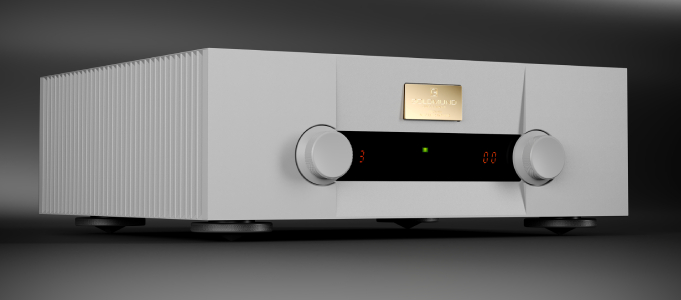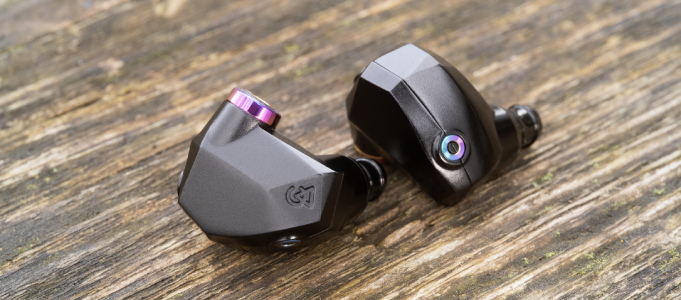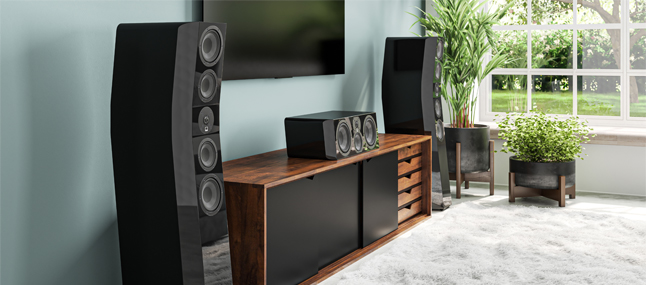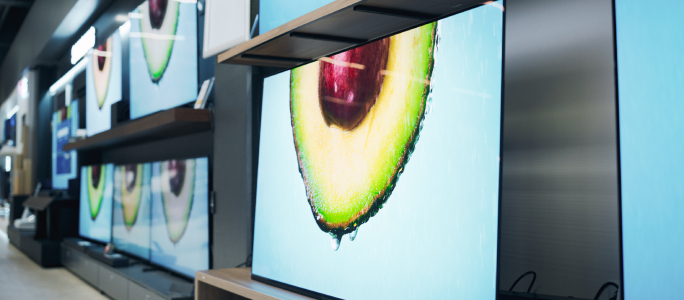Philips 65-inch OLED+935OLED 4K TV Review

John Archer is dazzled by this new top quality, high-end OLED television…
Philips
65OLED+935 TV
£2,499
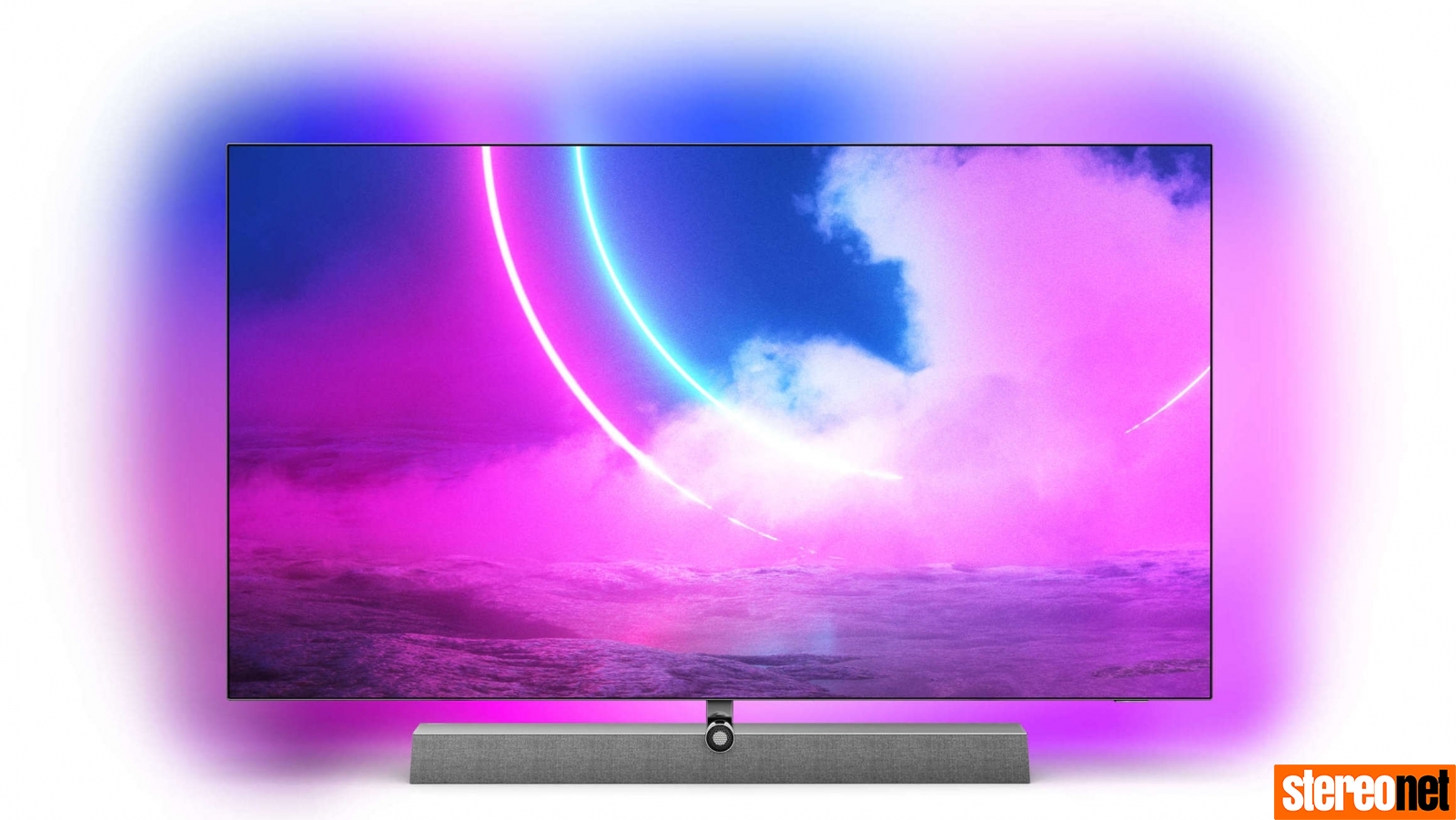
Never let it be said that OLED TVs are a bit samey. It's true that pretty much every OLED panel comes from a common source – LG Display – but that's not where the story ends, as the new £2,499 Philips 65OLED+935 – proves. As we shall see, it's pretty remarkable in a number of ways…
For starters, its screen sits on a slim, metal-backed plate that instantly gives the set a futuristic feel. This slimness only exists at the TV's outer edges, as a fair chunk of the rear's inner area sticks out much further – because those processors, connections and so on have to go somewhere – but it's still svelte. And this is helped by its use of an external speaker enclosure as its desktop stand, something that's as glamorous as the screen it accompanies, thanks to its aggressively angular shape, Kvadrat fabric front and metallic top edge.
Turn the 65OLED+935 on, and the screen becomes bathed in a four-side version of Philips' Ambilight technology. This uses LEDs arrayed down the TV's rear to cast out coloured light that can either be set to your favourite colour or track the colour content of the pictures you're watching. Ambilight always sounds a bit weird when you describe it on paper; however, research consistently shows it to be a popular feature with Philips TV buyers for the extra immersive qualities it can bring to the viewing experience. I'd urge you to use it on a fairly low level of brightness though, to stop it jumping from immersive to distracting.
UP CLOSE
This TV's external speaker box is quite a thing and the result of Philips' ongoing collaboration with British hi-fi brand Bowers & Wilkins. Tucked inside its tidy form is a 3.1.2 speaker array designed to unlock the power and precision of Dolby Atmos soundtracks via two drivers firing upwards through the enclosure's top edge, a dedicated bass driver, and front left, right and centre channels. Finally, one of B&W's top-quality tweeters sits centrally.

There's serious innovation going on with the pictures, too. Philips can always be relied upon to have an exceptionally powerful video processor in its top-end TVs – and many of its not so top-end TVs, actually. The OLED+935 takes this to another level by adding AI into the Philips processing mix for the first time. Essentially Philips has fed millions and millions of images through a neural network so that its AI system can 'learn' how to divide images – actually, parts of images – into five different categories, such as 'face' or 'nature'. This knowledge is then used to make it easier for the TV to decide in real-time how best to present all the different parts of any image it receives. Probably the best way to look at the way AI works in this instance is as a means not so much of boosting the power of Philips' main P5 processing engine, but making that engine work with more focus and efficiency.
The company's cheaper OLED805 TV range also benefits from the new AI system, but the OLED+935s gets more out of it and benefits from a few unique picture features. One of these is a system designed to combat OLED's susceptibility to permanent image retention if the screen is exposed for too long over months and years to static image elements such as channel logos. It's powerful enough to constantly analyse tens of thousands of sections of the image on the look out for static elements, dimming any it finds down slightly, so they don't place as much strain on the organic materials that in OLEDs. This new anti burn-in technology is clever enough not to cause channel logos, and such, to look distractingly dimmer than the rest of the image. Yet, Philips claims that the system should reduce the potential for screen burn by a mammoth ninety-five percent.

The 65OLED+935 also bags an exclusive AI Smart Bit processor not found on the cheaper OLED805 range. This is designed to remove the sort of colour banding that can sometimes show up in high dynamic range content without simply 'softening it away'. While these extra features for the OLED+935 might not sound massive on paper, the results they deliver are actually pretty remarkable.
Its connections are a mixed bag, and arguably the only weak link in an otherwise fearsome set of specs. They're numerous enough, but sadly don't join LG's latest OLED TVs in supporting such key next-generation game features as variable refresh rates and 4K playback at 120Hz. The 65OLED+935 does handle the automatic low latency mode feature that sets TVs into Game mode (for faster image rendering) when a game source is detected. However, the 37ms it still takes for images to appear on the 65OLED+935 even in Game mode isn't particularly speedy. For instance, LG and Samsung both achieve nearer 10ms with their 2020 premium TVs.
There's one final bit of good news for movie fans to enjoy – support for both HDR10+ and Dolby Vision 'active' HDR formats (alongside, of course, the more common industry standard HDR10 and HLG formats). These both add extra scene-by-scene data to HDR video streams to help compatible TVs deliver better picture results. Most TV brands only support either HDR10+ or Dolby Vision rather than both – even though there's content out there that's only available in one or the other format. So Philips opting to cover both formats means that with the 65OLED+935 you can be safe in the knowledge that it will give you the best possible experience from any HDR content you play on it.
PICTURE QUALITY
Adding AI to TV picture processing has yielded consistently impressive results with every brand that's tried it so far. Its impact on the 65OLED+935, though, is particularly profound. I personally have long been a fan of Philips' powerful picture processing. It's typically more aggressive than most, gleefully delivering levels of sharpness, colour punch, motion-clarity, brightness and contrast that rivals typically can't or won't match. This doesn't appeal to everyone though, and even I as a fan would say that there have been numerous areas of Philips processing that benefit from a little toning down – which means having to dive into Philips' generous but complicated picture menus. Cue the new AI system…

By enabling the 65OLED+935 to have a much more accurate idea of exactly what sort of content any given image contains, the AI features allow P5 processing to apply its effects in a much more locally appropriate way. Which leads to you getting the familiar benefits of Philips processing, but without the usual unwanted digital side effects. The single best example of this interplay between AI and P5 can be seen in the 65OLED+935's colour performance. Its pictures in Vivid or Standard modes still look strikingly vivid and rich, even by OLED standards. Yet this vividness is now less likely than it has been on previous Philips TV generations to throw up the occasional overcooked tone, or tonal imbalance.
If all this talk of vibrant colours doesn't sound like your cup of tea, fear not: the 65OLED+935's Movie picture preset has been calibrated out of the box to deliver an impressively accurate image according to established mastering standards. In fact, this flatter, less dynamic picture mode formally meets the requirements of the new Filmmaker Mode established by the independent UHD Alliance to deliver a truly 'as the director intended' image.

In other words, the 65OLED+935 can't be accused of not being interested in accuracy. It's now there at the press of a button, and you don't necessarily have to have the TV professionally calibrated. If on the other hand though, you're seduced by the richer, more dynamic things in TV colour life, you can now indulge that taste too without having to worry about nearly so many potential unwanted trade-offs.
The 65OLED+935's sharpness gives us another fascinating insight into what the AI can do. First impressions with both native 4K and upscaled HD sources are that its pictures aren't as extravagantly sharp as those of previous Philips generations. After more prolonged scrutiny, this turns out to be an incorrect assessment. What's actually going on is that Philips' sharpening tools are working more intelligently, targeting different areas and objects in the image with varying amounts of sharpness enhancement rather than just applying a one size fits all approach. Such 'object-based' analysis isn't entirely new to Philips TVs, but now AI is on hand to refine things further by categorising each object – and the results are beautiful.
The best way to describe what AI Sharpness does with 4K content is that it makes the image look like it has more depth of field. Objects look more solid and three dimensional, and your sense of the distance between foreground and background is increased. This reflects much more closely, of course, the way you see the real world.

With upscaled HD the AI sharpness feature works a little differently, but no less effectively. Here it seems to be working out how to enhance the sharpness and detail levels of different elements in the image in order to deliver the cleanest and most natural overall look, rather than just enhancing everything in the same way and potentially causing some areas to look harsh. Therefore, the 65OLED+935's upscaled pictures look more organic and immersive than on any previous Philips TVs.
The 65OLED+935's new system for removing colour banding also works well. Scenes from 4K Blu-ray known to give TVs a colour banding headache look impressively stripe-free, with only one or two faint traces remaining. And as promised, the banding is removed without simply softening the picture in the area of the banding.
Motion handling also sees Philips delivering its best ever results. This is chiefly due to a new PureCinema mode that re-orders frames rather than interpolating completely new ones. But the lowest power setting of the old Movie motion processing system also seems to deliver more natural results than it has before. Perhaps again because it's applying itself to more refined images thanks to AI.

Underpinning all this is OLED's familiar strength when it comes to black levels and local contrast. Though to simply imply that the 65OLED+935 just does as well as every other OLED where contrast is concerned would be doing it an injustice. The Philips actually picks up where its OLED+934 predecessor left off by managing, through clever picture and power management, to deliver the brightest, most intense looking HDR image peaks seen on an OLED TV. Moreover, it does so while also reproducing more subtle detail in dark scenes without compromising OLED's gorgeous black level response. The net result is arguably the most dynamic, truly HDR-looking images the OLED world has given us to date.
OLED TVs will never – with current technology – run as brightly as the best LCD TVs. However, with every TV generation Philips expands expectations of what OLED can achieve from HDR's massive (relative to the old SDR system) light range.
Are there any issues with the 65OLED+935's pictures aside from the one or two limitations I've already touched on? The Vivid mode Philips wants you to use can still be a touch over-aggressive at times, but switching to Standard instead is hardly a hardship. The noise reduction systems can still feel a bit over the top, particularly if you use the dedicated HDR AI picture preset. I'd suggest turning them off for 4K content, at any rate. That's about it for the bad stuff though, so it really doesn't amount to much!
SOUND QUALITY
The 65OLED+935's audio is even further ahead of the game than its pictures. The B&W speaker box produces a soundstage so large, so powerful, so detailed, so dynamic, so refined and so detailed that it's hard to believe you're not listening to a serious separates system. Even bass delivery is strong enough to persuade your ears that there must be a subwoofer hiding behind a chair somewhere.

The upfiring drivers deliver not just a sense of height with Dolby Atmos soundtracks, but specific layers/levels of verticality. Vocals seem to have been mildly lifted (vertically) in the mix, too, so that they appear to emerge exactly from the TV's screen, rather than from below it. The sound from the main drivers spreads far and wide without losing cohesion, and since they're forward-facing, they fill your room with sound rather than creating a soundstage that only seems to exist behind the screen, as happens with many regular TV sound systems.
It's impossible to catch the system out, too. Even the most extreme movie soundtracks are convincingly portrayed, with no distortion, cabinet rattles, treble harshness or dialogue muddying. While the sound system has clearly been designed to thrive on movie and TV soundtracks, B&W seemingly couldn't resist making it rock with music, too. Basically, there's a proper hi-fi sensibility to its detail and musical staging, underpinned by immaculate timing and crazy amounts of projection and power.
THE VERDICT
 Philips OLED TVs have always been good, but the combination of the company's new AI-inspired picture quality and B&W-inspired sound quality take the 65OLED+935 to a whole new level. This is an expensive television alright, but its brilliance makes it worth every penny.
Philips OLED TVs have always been good, but the combination of the company's new AI-inspired picture quality and B&W-inspired sound quality take the 65OLED+935 to a whole new level. This is an expensive television alright, but its brilliance makes it worth every penny.
Visit Philips for more information
John Archer
I’ve spent the past 25 years writing about the world of home entertainment technology. In that time I’m fairly confident that I’ve reviewed more TVs and projectors than any other individual on the planet, as well as experiencing first-hand the rise and fall of all manner of great and not so great home entertainment technologies.
Posted in:Home Theatre Visual Applause Awards 2021 Visual Televisions
Tags: philips bowers wilkins tp vision
JOIN IN THE DISCUSSION
Want to share your opinion or get advice from other enthusiasts? Then head into the Message Forums where thousands of other enthusiasts are communicating on a daily basis.
CLICK HERE FOR FREE MEMBERSHIP












